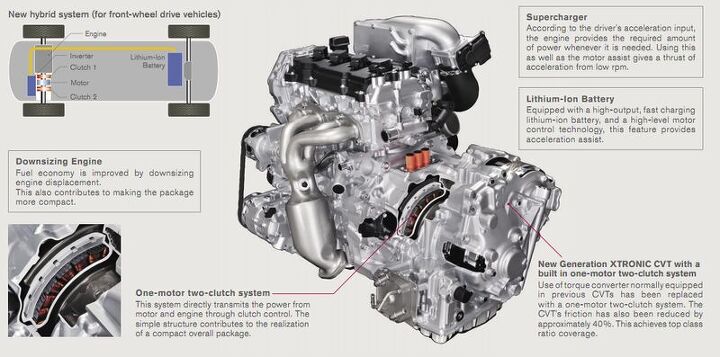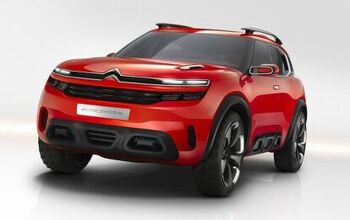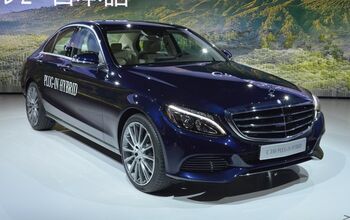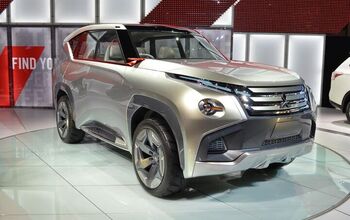Are You Ready For: Nissan's Supercharged Hybrid?
Of all the Japanese automakers, none are as far behind on hybrid technology as Nissan. For some time there was a sense that Nissan’s (relatively) huge investment in electric vehicle production would represent a “leapfrogging” of hybrid technology, but now the firm is using the common industry response to questions about future technology: a suite of options, rather than one single technology, will meet tomorrow’s low-energy transportation needs. As a result, Nissan’s been playing catchup, as it admits in a recent press release [ PDF]
“We must have a tougher job than any other hybrid team in the industry,” says Mitsunobu Fukuda, a senior powertrain engineer at NATC. “Because our CEO, Carlos Ghosn, used to be known as skeptical about the value proposition of hybrids we had to make a really compelling case that we could deliver value to customers to get him to validate a hybrid program.
In 2004, as a stopgap measure, Nissan licensed hybrid technology from Toyota for use in certain markets.
“It was a bit of a blow to our pride, but that was the right thing to do under the circumstances,” Fukuda says.“Instead of rushing out a ‘copy-cat’ hybrid we wanted to take the time to develop our own hybrid, one that is clearly different – and better. I think we’ve managed to do that.”
What makes Nissan’s forthcoming hybrid system so different? For one thing, it uses Nissan’s “one motor, two clutch” system (currently found only on the Infiniti M Hybrid), which enables a compact design. For another, it’s supercharged.
Nissan’s first in-house hybrid, the Infiniti M, highlights the firm’s approach to hybrids, with its simple two-clutch system that is fitted to the omnipresent continuously variable transmission. But having validated the rear-drive luxury version (see video above), Nissan is taking that design to the transverse, front-drive package. And because the “one motor, two clutch” design takes up the same amount of space as a traditional drivetrain (according to Nissan), this new hybrid system should be able to fit into many of Nissan’s mass-market products.
Supercharging has not played much of a role thus far in the industry-wide move towards downsized, forced-induction engines, playing its best-known role as half of VW’s “Twincharger” technology (which combinde both super- and turbocharging). But Nissan is already ahead of the curve, with its new Micra DIG-S, which combines a 1.2 liter, three-pot engine with a supercharger for its first sub-100 g CO2/km model. The key to supercharged efficiency? As Eaton points out, “downspeeding” can be as important as “downsizing.” Unlike turbos, superchargers don’t need high revs to build boost, so it can boost low-end torque more efficiently (which is where small engines most need the help). Combine that characteristic with a CVT, which can keep the engine operating at a near-maximum level of efficiency, and the benefits of a supercharging become more clear.
Of course, we still have a lot to learn about Nissans new supercharged hybrid. We do know that it is based around a 2.5 liter supercharged unit that Nissan says will spit out the same power as its 3.5 liter V6. This should help Nissan downsize its vehicle underpinnings as Hyundai has done, further benefitting fuel economy. Otherwise, we’ll have to wait until a 2013 debut before we know too much more about this new drivetrain. But one thing is certain: we’re going to have to get used to the idea of supercharging as a green technology, as well as a quick, bolt-on method of squeezing more power out of an engine.
More by Edward Niedermeyer
Latest Car Reviews
Read moreLatest Product Reviews
Read moreRecent Comments
- Theflyersfan The wheel and tire combo is tragic and the "M Stripe" has to go, but overall, this one is a keeper. Provided the mileage isn't 300,000 and the service records don't read like a horror novel, this could be one of the last (almost) unmodified E34s out there that isn't rotting in a barn. I can see this ad being taken down quickly due to someone taking the chance. Recently had some good finds here. Which means Monday, we'll see a 1999 Honda Civic with falling off body mods from Pep Boys, a rusted fart can, Honda Rot with bad paint, 400,000 miles, and a biohazard interior, all for the unrealistic price of $10,000.
- Theflyersfan Expect a press report about an expansion of VW's Mexican plant any day now. I'm all for worker's rights to get the best (and fair) wages and benefits possible, but didn't VW, and for that matter many of the Asian and European carmaker plants in the south, already have as good of, if not better wages already? This can drive a wedge in those plants and this might be a case of be careful what you wish for.
- Jkross22 When I think about products that I buy that are of the highest quality or are of great value, I have no idea if they are made as a whole or in parts by unionized employees. As a customer, that's really all I care about. When I think about services I receive from unionized and non-unionized employees, it varies from C- to F levels of service. Will unionizing make the cars better or worse?
- Namesakeone I think it's the age old conundrum: Every company (or industry) wants every other one to pay its workers well; well-paid workers make great customers. But nobody wants to pay their own workers well; that would eat into profits. So instead of what Henry Ford (the first) did over a century ago, we will have a lot of companies copying Nike in the 1980s: third-world employees (with a few highly-paid celebrity athlete endorsers) selling overpriced products to upper-middle-class Americans (with a few urban street youths willing to literally kill for that product), until there are no more upper-middle-class Americans left.
- ToolGuy I was challenged by Tim's incisive opinion, but thankfully Jeff's multiple vanilla truisms have set me straight. Or something. 😉


































Comments
Join the conversation
Why don't they license the electric turbocharger from Ecomotors? Motor provides boost until RPMs come up, and then instead of overboost blowoff use the motor to generate power..
Doesn't super or turbo charging require the use of premium fuel? At least my WRX and Beetle Turbo both did as well.